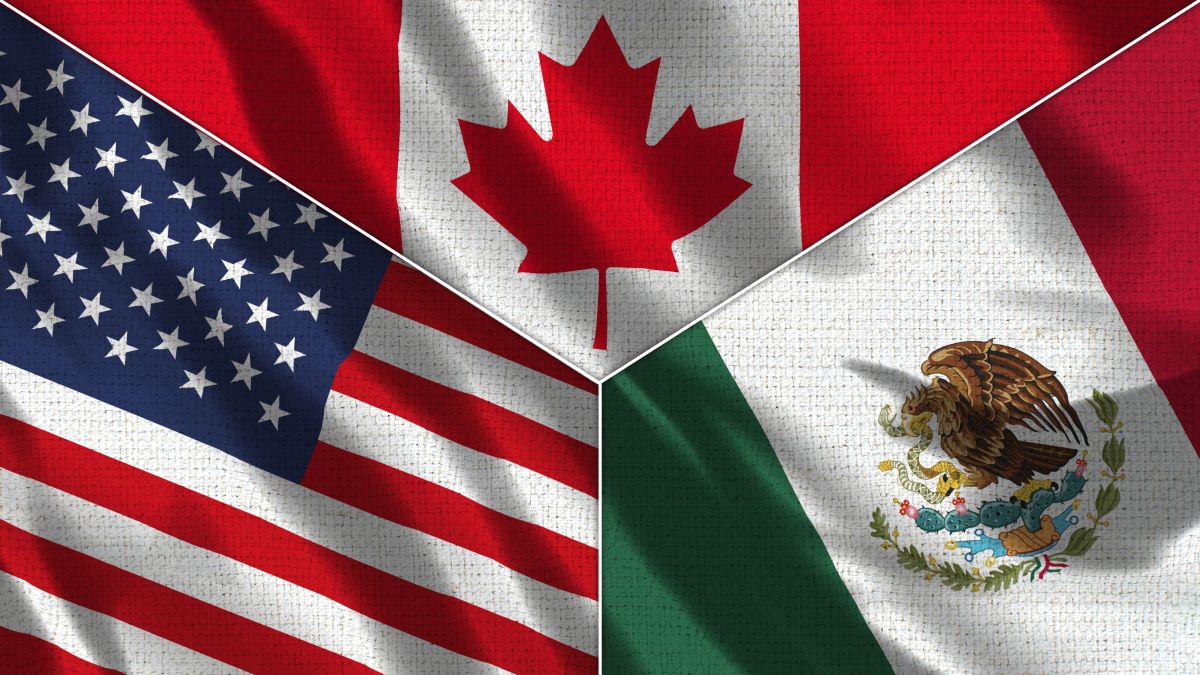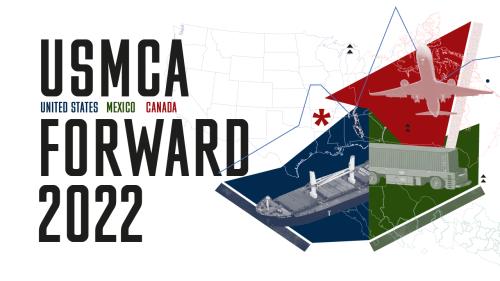July 1, 2023 marked the three-year anniversary of the United States-Mexico-Canada Agreement (USMCA), providing an opportunity to reflect on its impact on North American trade and investment and explore ways to further strengthen economic collaboration in the region.
As outlined in last year’s policy brief marking the second anniversary of the agreement, the USMCA is key to building a more competitive, sustainable, and inclusive North American economy. The agreement’s passage through the legislatures of all three countries with overwhelming political support exemplifies effective international economic cooperation that benefits numerous stakeholders.
Since the passage of the USMCA, the COVID-19 crisis, Russia’s invasion of Ukraine, and rising economic and strategic tensions with China have renewed awareness of the importance of North America to enhance supply chain resilience, mitigate risks associated with reliance on China, and foster the development of industries crucial for security, climate, and competitiveness going forward. In his April speech at Brookings, United States National Security Advisor Jake Sullivan, underscored the importance of working with partners to build resilient and secure supply chains in industries such as semiconductors and clean energy and critical minerals and batteries. More broadly, U.S. international economic policy is shifting from a focus on trade policy to a focus on investment.1 All of this underscores the significance of the USMCA. The agreement also includes rules and commitments on investment that can guide and sustain increased investment across North America in pursuit of these key objectives.
The last three years show significant progress in expanding trade, investment, and jobs, as well as ensuring USMCA delivers outcomes that are good for workers and broader group of society across North America. Trade and investment have expanded across the region, and cooperation among officials, industry, and civil society has strengthened and deepened. The USMCA dispute resolution mechanisms have been utilized, which demonstrates an investment by all governments in the rules. Furthermore, the success of the labor chapter rapid response mechanism has underscored how this new type of trade agreement can lead to material impacts on working conditions. More broadly, USMCA has provided the policy certainty and baseline for North America as a key platform for building complete supply chains in areas such as electric vehicles (EVs) and semiconductors, addressing climate change and developing clean energy, and expanding access to critical minerals, to mention a few. In short, USMCA has underpinned the economic relationship and is increasingly a key element of broader geostrategic competition with China.
At the same time, there are real challenges that must be addressed if North America is to maximize the opportunities that USMCA presents. This includes compliance by all governments with their USMCA commitments, including USMCA dispute settlement findings. There are also areas where deeper cooperation will be needed to achieve the broader goals of more secure and resilient supply chains in expanding manufacturing in North America. This includes in areas such as regulatory alignment, digital trade and data flows, worker training, and expanding opportunities for small and medium enterprises (SMEs), to name a few.
Assessing the state of the economic relationship
In 2022, the total value of trade within North America exceeded $1.5 trillion, equivalent to nearly $3 million per minute and the result of double-digit growth in trade over the past two years. This impressive growth in trade over the past two years has made Mexico and Canada the top trading partners of the United States, with trade volumes 44% higher than U.S. goods trade with China. Combined, the three countries now account for almost a third of global GDP, and intra-regional goods trade alone supports 9.5 million jobs across North America (Brookings USMCA Tracker).
In addition, intra-regional investment has also grown, with the U.S. being the largest destination for Mexican and Canadian investment, and Mexico and Canada receiving 11% of U.S. foreign direct investment (FDI). This positive trend is benefiting all countries in North America, just as capital investment into the region grew 134% since the implementation of USMCA and reached $219 billion.
To illustrate, in the first three months of 2023, inward FDI in Mexico experienced a remarkable 48% surge compared to the same period in 2022. Notably, the manufacturing sector saw its share of the country’s FDI double from 24% to 53% with 5 out of 10 new dollars invested in Mexico during the first quarter of 2023 originating from Canada and the United States. On the Canadian side, nearly half of all FDI in 2022 came from its North American partners as well. Furthermore, FDI in Canada increased by 23% from 2020 to 2022, highlighting the strengthening economic ties within the region.
These encouraging figures are expected to continue growing in the coming years, driven by new investments in resilient supply chains, EVs, semiconductors, infrastructure, and other emerging technologies. The Inter-American Development Bank (IDB) estimates nearshoring, particularly in sectors such as the auto industry, textiles, pharmaceuticals, and renewable energy, could result in Mexico increasing its exports by $35 billion in the coming years.
The U.S. government also foresees substantial investment opportunities on the horizon. Initiatives such as the Bipartisan Infrastructure Bill, the CHIPS and Science Act, and the Inflation Reduction Act (IRA) are projected to generate approximately $3.5 trillion in investment for the United States over the next decade.2 Canada is also leveraging USMCA and realizing the opportunities for expanding trade and investment in North America, having launched a $1.5 billion Canadian Critical Minerals Infrastructure Fund, and their 2022 Critical Minerals Strategy is supported by a budget of nearly $4 billion. In 2020, a Canada-U.S. Joint Action Plan on Critical Minerals was announced to support over $95.6 billion in bilateral mineral trade.
USMCA retains many of the North American Free Trade Agreement’s (NAFTA) core features such as zero tariffs and commitments in areas such as standards and services and was updated in important ways. One of the most significant updates in USMCA was a new chapter on digital trade and enforceable labor and environmental commitments along with an innovative dispute settlement mechanism that allows for facility-based enforcement of labor commitments. To date, there have been 13 labor complaints using USMCA’s new Rapid Response Labor Mechanism (RRM), resulting in eight prompt and positive dispute resolution that led to improved wages and better working conditions for Mexican workers and unions. Some experts argue, however, that these settlements—85% in the auto industry—will do little to improve on overall market conditions in Mexico.
More significant is USMCA’s contribution to stability in rules and norms, reducing the risk to trade and investment across North America.3 Building on the foundation set by the USMCA, over the last three years, the three governments have also developed new mechanisms to further deepen cooperation and opportunities for economic exchange. For instance, all three leaders relaunched the North American Leaders Summit (NALS), which has focused on ways to deepen and expand economic cooperation including in supply chains related to semiconductors and critical minerals and the development of clean energy and coordination on illegal migration and trafficking in persons and arms issues.4
The three governments organized the North American Semiconductor Conference in May 2023 and launched the North American Ministerial Committee on Economic Competitiveness that will align each government’s work to improve the competitiveness and productivity of key industries such as semiconductors, clean energy, critical minerals, bio-manufacturing, and information and communications technology (ICT). The relaunch of the U.S.-Mexico High-Level Economic Dialogue (HLED) in 2021 has developed four pillars of work built around more resilient supply chains, sustainable economic development, tools to mitigate risk in ICT, and joint efforts to promote innovation and workforce development. And Canada and the U.S. are working together to expand opportunities created by the IRA and CHIPS and Science Act.5 All of the USMCA’s expanding cooperation rests on the rules and framework that USMCA provides for governing North American economic relations.
A joint review of USMCA in 2026
An important date going forward is July 2026. The USMCA requires a “joint review” of the agreement six years after its entry into force. USMCA was approved for an initial 16-year term, with the possibility of extension and commitment to hold this review. The governments will review the operation of USMCA, assess recommendations for action submitted by one of the governments, and decide on any appropriate actions, which could include an extension of the agreement for another 16 years. (See USMCA, Article 34.7: “Review and Term Extension.”)
Therefore, much of the agenda going forward will consider the upcoming review of USMCA’s performance and opinions of stakeholders and political actors in each country on how well USMCA has done to date. Failure to renew USMCA in 2026 would complicate investment and business planning and reintroduce significant uncertainty in economic relations across North America.
1. Compliance with USMCA dispute settlement outcomes
All governments have utilized USMCA dispute settlement mechanisms, including state-state disputes and the labor chapter’s rapid response mechanism. Disputes are expected to arise due to the large and complex economic relationship within the region. Channeling trade irritants into legalized dispute settlement processes provides a political space to encourage and expand economic cooperation. That said, failure to comply with the outcomes from USMCA dispute settlement mechanisms reduces confidence in USMCA rules and increases risks to traders and investors. The Brookings USMCA Scorecard tracks compliance by the three governments with their USMCA commitments. The three biggest disputes underway are related to Mexico’s energy policies and practices; Mexico’s approach to genetically modified corn; and the U.S. method for calculating the rules of origin for vehicles. Many stakeholders will be carefully watching to see if the parties can forge solutions to these three disagreements.
2. Labor
USMCA’s labor chapter and its rapid response mechanism (RRM) are one of the agreement’s innovations. Demonstrating that the RRM can deliver results and support labor rights in Mexico has been a priority for the Biden administration. Support for USMCA by the American Federation of Labor and Congress of Industrial Organizations (AFL-CIO) was in large part a result of the labor chapter and its RRM. More broadly, the U.S. has pointed to USMCA and the RRM as a model for future trade agreements. In a speech she gave in mid-June, U.S. Trade Representative Katherine Tai highlighted USMCA as an example of the new worker-focused trade policy. As such, continuing to show how the USMCA labor chapter can address labor rights in Mexico will remain important for ongoing U.S. support for USMCA. That said, level-setting what the USMCA labor chapter can deliver is also important. Analysis shows, for instance, that the USMCA labor chapter should not be expected to lead to increased average wages in Mexico, though it could result in small increases in wage rates in those sectors exporting to the U.S.6
On a related track, the U.S. has been supporting the Mexican government’s implementation of its labor reforms. To this end, the U.S. has deployed five attachés in U.S. embassies and consulates in Mexico to support implementation of USMCA labor commitment along with $210 million over four years to assist Mexico in implementing labor reforms and $180 million over four years to assist with technical assistance projects.7 Though the labor reforms process is not progressing as fast as some hoped, this will remain a priority for bilateral cooperation. More broadly, continuing to show how the USMCA labor chapter and RRM can result in meaningful improvements in Mexican labor rights can help sustain support by U.S. unions for USMCA. In addition, better implementation of labor rights can feed into more efficient and resilient North American supply chains with fewer strikes. For example, Kevin Kolben argues that creating responsive and effective institutions to resolve disputes might lead to less conflict between employers and employees and overall higher labor standards.8 This could in turn mitigate supply chain risks by reducing the number of workplace actions.
Another area where USMCA labor commitments are important and could assume greater focus going forward is on the commitment all three governments have made to eliminate trade in forced or compulsory labor. Work done as part of the Brookings USMCA initiative shows that forced labor from China continues to enter the North America supply chains.9 Making progress on this front will require cooperation including among customs agencies in the three countries and access to intelligence to better map supply chains.
3. Digital trade
Cooperation on digital trade policies has enormous potential, given the increasing use of digital technology and services across all economic sectors and the scope for artificial intelligence (AI) to drive economic and trade gains.10 USMCA has one of the most comprehensive commitments governing digital trade. These commitments provide a key foundation for developing the world’s most advanced digital marketplace including with respect to AI. Indeed, the three governments, in partnership with industry and other stakeholders, should develop a blueprint for a digital North America. Such a blueprint could involve identifying how to digitize trade and deploy AI to improve the competitiveness and efficiency of North American trade. Making progress here could be done as part of the USMCA Competitiveness Commission or as a separate body focused on technology opportunities for North America.11 It would also involve North America taking the lead in setting digital regulation including for AI and should include expanding opportunities for SMEs to engage in digital trade.
A related area for cooperation going forward should be on cybersecurity. This is critical given integration of supply chains and for national security reasons. There is already considerable cooperation. The U.S. National Institute of Standards and Technology (NIST) Cybersecurity Framework provided a good basis for industry alignment on developing good cyber practices as well.
4. Small and medium enterprises
Fostering additional participation in USMCA will remain a priority because of the economic and job potential SMEs bring to the table and because of the potentially larger role of SMEs as enthusiastic stakeholders in USMCA’s success. The governments are organizing SME forums, but given the number and variety of SMEs across North America, success will take persistent efforts, the involvement of multiple ministries from all three countries, expanded capacity-building efforts, and development of new tools to foster greater SME use of the USMCA.
5. Regulatory alignment
Enhanced regulatory cooperation should be a high priority going forward.12 Progress could greatly facilitate commerce while protecting consumers. As the U.S. trade representative and others recently put it, “good regulatory practices are fundamental to transparent governance and fair trade.” In USMCA, however, not much progress is evident to date under Chapters 12 and 28, which address improved regulatory cooperation. The three governments are not actively using the Committee on Good Regulatory Practices called for under Chapter 28, for example. That committee could serve as a central coordinating body for enhancing dialogue, collaborating on more standard Regulatory Impact Assessments (RIAs), improving transparency, and setting priorities for enhancing collaboration in areas not specifically addressed in USMCA. The agreement’s Chapter 12 contains key sectoral annexes covering chemical substances, cosmetic products, ICT, energy performance standards, medical devices, and pharmaceuticals. These are all areas where “enhancing regulatory compatibility” could bring many benefits. The U.S. and Canada previously had productive regulatory dialogues, and the U.S. and Mexico did so on specific sectors. However, Mexico has not shown interest in pursuing strong regulatory cooperation.
6. Workforce development
Support for workforce development is a priority in USMCA’s implementation and outlined in the North American Leaders Summit (NALS) agenda for strengthening the continent’s competitiveness. The North American workforce still suffers from long-standing skills gaps and mismatches, which will weigh heavily on the region as it tries to build resilience in its supply chains, deploy new technologies, and meet the challenges from China and elsewhere.13 USMCA’s Competitiveness Committee has begun a dialogue on workforce development, but so far the efforts to address these needs have been limited, especially given the emphasis placed by the three governments on supporting workers, as U.S. Trade Representative Tai highlighted in her June speech. Work within USMCA’s mandate can help the United States, Canada, and Mexico to increase and better target investment in their workforces. For example, in May, U.S., Canadian and Mexican economic ministers agreed on a multi-year effort to “train the semiconductor workforce of the future.”
Specifically, the trade ministries could:
- Identify successful examples of private and public collaboration to strengthen USMCA value chains, including showing how companies have been incentivized to invest in worker reskilling and upskilling.
- Identify approaches and strategies to encourage companies to collaborate with educational institutions, trade unions, sub-federal governments, and others to better align curricula with the evolving labor market needs and better connect graduates to the labor market.
- Build tri-national spaces to share best practices across the continent on partnerships that link the priorities of business, academic, and government actors in dealing with technological change and growing global competition.
Such efforts could produce agreement on pilot programs where the national governments could partner with businesses, labor groups, academia, and local governments to foment workforce capacity building in key USMCA sectors.
7. Emergency planning
In February 2023, the USMCA partners established a special subcommittee to enable timely cooperation during emergencies, recognizing the serious disruptions that arose during the COVID-19 pandemic and that might arise in the future. Officials should roll out in the weeks ahead proposed areas of agreement (e.g., identification of sectors essential during an emergency, procedures for coordinating responses, and plans for practice exercises).
8. Environment
Solid work on environmental issues is important for the trade deal’s credibility, but USMCA’s environmental chapter does not cover climate change commitments. Most of the work on promoting clean/green energy and conservation is taking place in bilateral discussions or in the context of the NALS work agenda. There has been activity regarding protection of flora and fauna, with the U.S. requesting USMCA consultations on the endangered vaquita porpoise, illegal fishing, and trafficking of totoaba fish.
More broadly, the environmental agenda for North America will be increasingly centered around climate change and in particular the transition to clean energy sources of electricity and the development of EVs. Whether USMCA needs to be updated to support these environmental/climate goals is an open question. Relatedly, the trade and climate issues—and diverging views and interests on climate mitigation—raise the stakes of international trade and its impact on climate goals and competitiveness. This is where Mexico’s failure to decarbonize its electricity supply at pace with the U.S. and Canada could put trade with Mexico at risk of climate-based measures such as the carbon border taxes in the EU.14
It would not be surprising for stakeholders to request more environmental coverage, including on climate, in the run-up to USMCA’s six-year review.
9. Transparency, outreach, coordination, and measuring success
The recent U.S. government requests for stakeholder input and the scheduling of USMCA committee meetings are welcome. It would be beneficial to have a more transparent, forward-looking schedule and improve information available on the U.S., Canadian, and Mexican government websites about ongoing work, including committee meetings and stakeholder outreach. This can help build public understanding and involvement moving toward USMCA’s six-year review.
The three governments should also coordinate outreach efforts to educate their publics about the progress made under USMCA and how USMCA’s work compliments other North American collaborations underway. There is impressive cross-continental work being pursued, highlighted by the NALS work agenda and by the May follow-up meeting among economic ministers on semiconductors and economic competitiveness. But there has not been much public attention, discussion, or evident understanding by key audiences about the work in progress. In this regard, USMCA partners should prepare for potential criticisms of the agreement during the electoral season in the U.S. and Mexico.
USMCA is off to a strong start bolstering prosperity across North America. However, there will need to be progress on a range of important issues in the next three years to effectively engage many stakeholders across North America. The U.S., Mexico, and Canada will also need to coordinate on USMCA’s implementation of the broader competitiveness agenda moving forward. And, lest we forget, politics in all three countries will need regular attention in order to garner support for the agreement.
An update
Trade ministers from Canada, Mexico, and the United States convened in Cancún on July 6-7 for a Free Trade Commission meeting. Official statements reveal that both the United States and Canada expressed concern regarding Mexican policies pertaining to energy and agriculture. These issues are presently being addressed through dispute settlement consultations under the framework of the USMCA. In addition to these concerns, the United States emphasized environmental issues linked to fisheries, specifically the preservation of the vaquita porpoise. The United States also underscored the importance of addressing regulatory uncertainties and the need for enhanced monitoring of steel and aluminum trade influx from Mexico. There was no mention of auto rules of origin during the discussions. Furthermore, during discussions with Canada, the United States raised the issue of digital taxes.
Moving forward, the ministers agreed to intensify their efforts in several key areas. These include prioritizing workforce development, fostering an environment conducive to open investment, and focusing on the needs of small and medium-sized enterprises to ensure inclusive trade practices. Additionally, the ministers pledged to sustain their endeavors in addressing labor-related concerns, particularly those related to forced labor. They also agreed to establish effective protocols for managing potential emergency situations that may arise in the future.
-
Footnotes
- Remarks by Deputy National Security Advisor Mike Pyle, 29 June 2023 at the Carnegie Endowment for International Peace. https://carnegieendowment.org/2023/06/29/future-of-international-economic-policy-with-deputy-national-security-advisor-mike-pyle-event-8122
- Speech by NSA Sullivan, April 2023, https://www.whitehouse.gov/briefing-room/speeches-remarks/2023/04/27/remarks-by-national-security-advisor-jake-sullivan-on-renewing-american-economic-leadership-at-the-brookings-institution/
- USITC, U.S.-Mexico -Canada Trade Agreement: Likely Impact on the U.S. Economy and on Specific Industry Sectors”, Pub. No. 4889, April 2019 https://www.usitc.gov/publications/332/pub4889.pdf
- https://www.whitehouse.gov/briefing-room/statements-releases/2023/01/10/fact-sheet-key-deliverables-for-the-2023-north-american-leaders-summit/
- https://www.whitehouse.gov/briefing-room/statements-releases/2023/03/24/fact-sheet-strengthening-the-united-states-canada-partnership/
- Santiago Levy and Oscar Fentanes, “NAFTA-USMCA and wages in Mexico,” USMCA Forward 2022, https://www.brookings.edu/essay/usmca-forward-building-a-more-competitive-inclusive-and-sustainable-north-american-economy-labor/
- https://www.dol.gov/agencies/ilab/our-work/trade/labor-rights-usmca
- Kevin Kolben, “Labor chapters improve supply chain resilience: The case of the USMCA,” USMCA Forward 2023, https://www.brookings.edu/articles/usmca-forward-2023-chapter-7-labor-standards/
- Alan Bersin and Thomas Ewing, “Technology can address supply chain visibility to bolster human rights, resilience, and sustainability,” USMCA forward 2023, https://www.brookings.edu/articles/usmca-forward-2023-chapter-8-transparency/
- Joshua P. Meltzer, “The impact of AI on international trade,” https://www.brookings.edu/articles/the-impact-of-artificial-intelligence-on-international-trade/
- Patrick Leblond, “The USMCA and digital trade in North America,” USMCA Forward 2022, https://www.brookings.edu/articles/usmca-forward-building-a-more-competitive-inclusive-and-sustainable-north-american-economy-digital/
- Beatriz Leycegui, “Non-tariff measures as barriers to deepening and strengthening North American supply chains,” USMCA Forward 2023, https://www.brookings.edu/articles/usmca-forward-2023-chapter-5-non-tariff-measures/
- Sylvia B. Ortega Salazar, “Preparing Mexican youth to harness job opportunities in North American higher technology supply chains,” USMCA Forward 2023, https://www.brookings.edu/articles/usmca-forward-2023-chapter-3-human-capital/
- https://taxation-customs.ec.europa.eu/carbon-border-adjustment-mechanism_en
The Brookings Institution is committed to quality, independence, and impact.
We are supported by a diverse array of funders. In line with our values and policies, each Brookings publication represents the sole views of its author(s).









